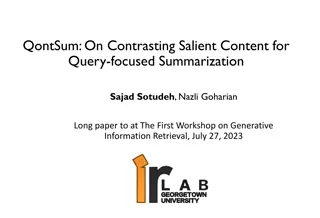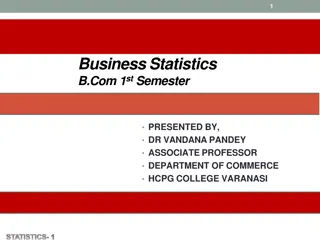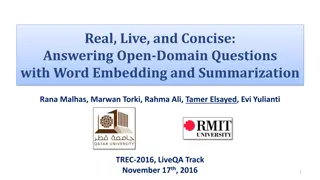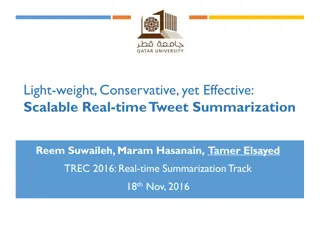
Data Summarization: Central Tendency, Distribution, Skewness, and Kurtosis
Explore the essentials of data summarization, including measurements of central tendency like mean, mode, and median, distributions, skewness, and kurtosis. Learn how to interpret and analyze data effectively.
Download Presentation

Please find below an Image/Link to download the presentation.
The content on the website is provided AS IS for your information and personal use only. It may not be sold, licensed, or shared on other websites without obtaining consent from the author. If you encounter any issues during the download, it is possible that the publisher has removed the file from their server.
You are allowed to download the files provided on this website for personal or commercial use, subject to the condition that they are used lawfully. All files are the property of their respective owners.
The content on the website is provided AS IS for your information and personal use only. It may not be sold, licensed, or shared on other websites without obtaining consent from the author.
E N D
Presentation Transcript
Data summarization: Data summarization is either by; 1) Measurements of central tendency (average measurements, measurements of location, and measurements of position) 2) Measurements of distribution measurements) 3) Skewness( 3) : Skewed to right (tail to right) or skewed to left (tail to left). 4) Kurtosis ;The normal distribution is mesokurtic 4 = zero, platekurtic or leptokurtic. variability (dispersion,
Measurements of central tendency: 1-Mean: It refers to the arithmetic mean, which is the average of a set of observations; it is obtained simply by summation of all observations divided by their number. The mean is characterized by; 1) Always present for each set of data there is a mean, even if there are two observations they have a mean . 2) Simplicity the mean is simple, easy to be obtained, easy to be calculated, and easy to be understood . 3) Uniqness for each set of data there is one and only one mean . 4) The value of the mean is highly affected (distracted, distorted) by the presence of extreme values (in case we have three hemoglobin level values 12.5, 13 & 14 their mean is highly different when we have an extremely low 9 or extremely high 17 value that give a lower or a higher estimate fore the mean than its real value).
2- Mode: values, or it is the most frequent observation in a set of observations. It refers to the fashionable data or the most recurrent value. The mode is characterized by; 1) Could be present, could be absent. For the following hemoglobin values 11.3, 12.5, 14.2, & 10.6 there is no mode. 2) Simplicity the mode is simple, easy to be obtained, need no calculation, and easy to be understood . 3) Not unique The mode if present could be one mode unimodal or two modes bimodal or there could be three modes trimodal etc 4) The mode unlike other measures can be used for presentation of the qualitative data, such as the most preferred type of food by patients in hospital, or the most occurring disease in the outpatients at certain time of the year, etc.. It is the value that has the highest frequency in a set of
3 -Median: when they are arranged in order. Or it is the value that divided the data into two equal parts equalhalves when they are arranged in order. So in order to find the median of a group of values, we need to arrange the data in ordered array from the smallest to the largest value then we find the position of the median position of the median = (n+1)/2 If there is an odd number of observations, we have one position of the median (n+1)/2 , which is that value that lie in this position. If we have an even number of observations, there are two positions of the median n/2 and n/2 +1 which is also found by the equation (n+1)/2 . So we find these values and take the average of them (first value + second value)/ 2 . It is the middle observation in a set of observations
The median is characterized by; 1. Simplicity the median is simple, easy to be obtained, easy to be calculated, and easy to be understood . 2. Uniqness for each set of data there is one and only one median . 3. The value of the median is not that affected by the presence of extreme values (in case of mean the extreme value will enter by its value in the calculation of the mean, but in median it will change the position of the median only by one step, so it will have no or less effect on the median value).
For the calculation of the measures of central tendency; e.g. 1: The plasma volume of 8 healthy adult males: 2.75, 2.86, 3.37, 2.76, 2.62, 3.49, 3.05, & 3.12 liters
e.g. 2: The parity distribution of mothers attending ANC clinic in the PHC of Hay-Al-Salam for the year 2004.
By drawing the curve, it take the shape of smooth curve (S) shaped or what is called sigmoid shape curve. Then taking the point of 50th percentile, 50%, draw a horizontal line from it which cuts the curve at a point, then drop a vertical line from that point to the x-axis, this point represent the exact value of the median.
Measurements of variability: The degree to which numerical (quantitative data) tend to spread about an average value is called variation or dispersion of the data. The variability is something that is in the nature of data, i.e. the data always have a variation (not came as one value). There are various measures of variation or dispersion are available but the most common being used are;
Range: It refers to the difference between the smallest and the largest value in a set of values. Range (R) = Largest value (XL) Smallest value (XS) The range is of limited use in statistics as a measure of variability because it takes in consideration only two values and neglect the others, and these two values considered by the range are the two extreme values (smallest and the largest values) which are not of that high interest in biostatistics to describe perfectly the variation.
The uses of range 1. It gives an idea about the extent of data distribution (the scale or range on which the data extend or spread). 2. In determining the width of class interval in case of class interval table (W=R/K).
2- Variance: The variance is defined as the average of the squared deviation of observations away from their mean in a set of observations. It represents a squared value (so it has no units mostly, as it is not accustomed to use meter2 for length square as a measurement) we obtain the variance value (2/n-1);
Standard deviation: The SD is defined as the squared root of the variance, or the positive squared root of the variance or it can be defined as the average of the deviation of observations away from their mean in a set of observations. It is the measure that is accustomed and widely used in biostatistics as a measure of variability. If the value of SD is high it means a large variation the data posses, and if it is of small value it mean a less variation the data posses.
Coefficient of variation (CV%): It is the standard deviation expressed in percentage out of the mean. It is used in statistics in the following states; 1. To compare the variability of two groups for the same variable but measured by different units (birth weight measured in Iraq by Kilograms and in England measured in bounds). So we cannot compare the variability of the two groups by SD but we can compare it by (CV%). 2. To compare the variability of two groups for the same variable measured by the same units and they have the same SD value but different means.
e.g. 1: The plasma volume of 8 healthy adult males: 2.75, 2.86, 3.37, 2.76, 2.62, 3.49, 3.05, & 3.12 liters
Median = (2.86 + 3.05) / 2 =2.955 (this value divided the data into two equal parts before it there is 4 values and after it there is 4 values). Mode: There is no value occurs more than the others, so there is no mode here. Range=XL XS= 3.49-2.62= 0.77 Liter
L=Lower limit of the C.I. containing the median = 11 r= remaining number until reaching the position of the median r=(n/2)-the previous cumulative frequency =70/2 - 18= 17 f= frequency of the C.I. containing the median = 19 W=width of the C.I.





















